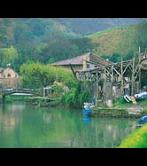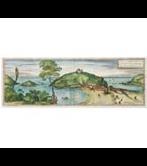Shipyards and ship owners
Shipbuilding, like the caseríos, reflects the social and economic development of Gipuzkoa. Shipbuilding in Gipuzkoa passed through various stages, starting with galleys and sailboats in the 12th century and on to more sophisticated designs and ships that could travel greater distances. These changes were already noticeable in the 13th century when, although fishing and coastal vessels such as skiffs still used oars, there were advances in much larger sailing ships. These comprised ever more complicated spar constructions, symmetrical designs with the helm above a flat stern. In order to make the vessels more self-contained on their voyages, they became bigger, with bigger sails and living quarters.
The development of shipbuilding goes hand-in-hand with that of the villas, and not just through the growth of a group of people linked to making ships or all the associated trades (sawmills, rope works, sail makers, and ironwork of every sort) but because of the forest management needed to guarantee supplies, the creation of foundries to guarantee tools etc. This development matched the growth in transport and trade these vessels were involved in, which called for an increase in mule traffic, road building, traders who worked in buying and selling on a small and large scale and food production (including cider) in order to supply the growing sector of the population that did not work in agriculture. It affected, to a greater or lesser degree, the entire region, not just the coast.
At the end of the 16th century, with the expansion of transatlantic trade and fishing, the Gipuzkoa shipyards also expanded. Scaffolds for shipbuilding proliferated initially at the mouth of the Urola, then Zumaia, in Deba and in Mutriku. Towards the end of the century there was a concentration of shipyards in the Oria estuary, the Bay of Pasaia and the Oiartzun ria. The big ships (galleons, ships of the line and frigates) and the wide variety of types built are the key features of an era dominated by the demands of Royal Navy and the Royal Fleet in general, by American trade, and much later, by the Commercial Companies (Caracas and the Philippines, in the 18th century).
It was technical advances, rather than large quantities of ships, that Gipuzkoa brought to the Navy in the 17th century. During the second half of the century, traditional shipbuilding methods were called into question. There were changes in the proportions and the layout and the ideas and designs of Antonio de Gaztañeta dominated. The Spanish Crown’s foreign wars tied up a large part of its naval resources, which let to the rebuilding of the Navy in which the Gipuzkoa shipyards played a part. Shipbuilding at the time followed French thinking, with galleons substituted by ships of the line. The destruction of the Pasaia shipyards by French troops in 1719 led to work for the Crown moving to In Cantabria, but still supervised by Gaztañeta. Even so, between 1713 and 1730, 31 ships were built in Gipuzkoa.
After 1729 shipbuilding criteria changed under the influence of the English, inspired by Jerónimo Aizpurua Etxebeste and under the auspices of the Marqués de la Ensenada. Optimum use was made of resources and production was speeded up. These innovations were driven by the Aizpurua family, who were based in Pasaia. The family went on building ships until the 20th century. A good example of their work is the ship “San Martín” (1746) on which Juan Arizmendi, Nicolás Aizpurua and Manuel Aizpurua worked together.
Shipyards at this time weren’t industrial hangers of the type we see in the 20th century, but ships were built in the open air, beside the swell and the tides. A platform and steps, inclined to make it easier to work, were the only structures. The canal, wharf and ramp used by the Caracas Company in the Bizkaia neighbourhood of Donibane, are a good example of this.




